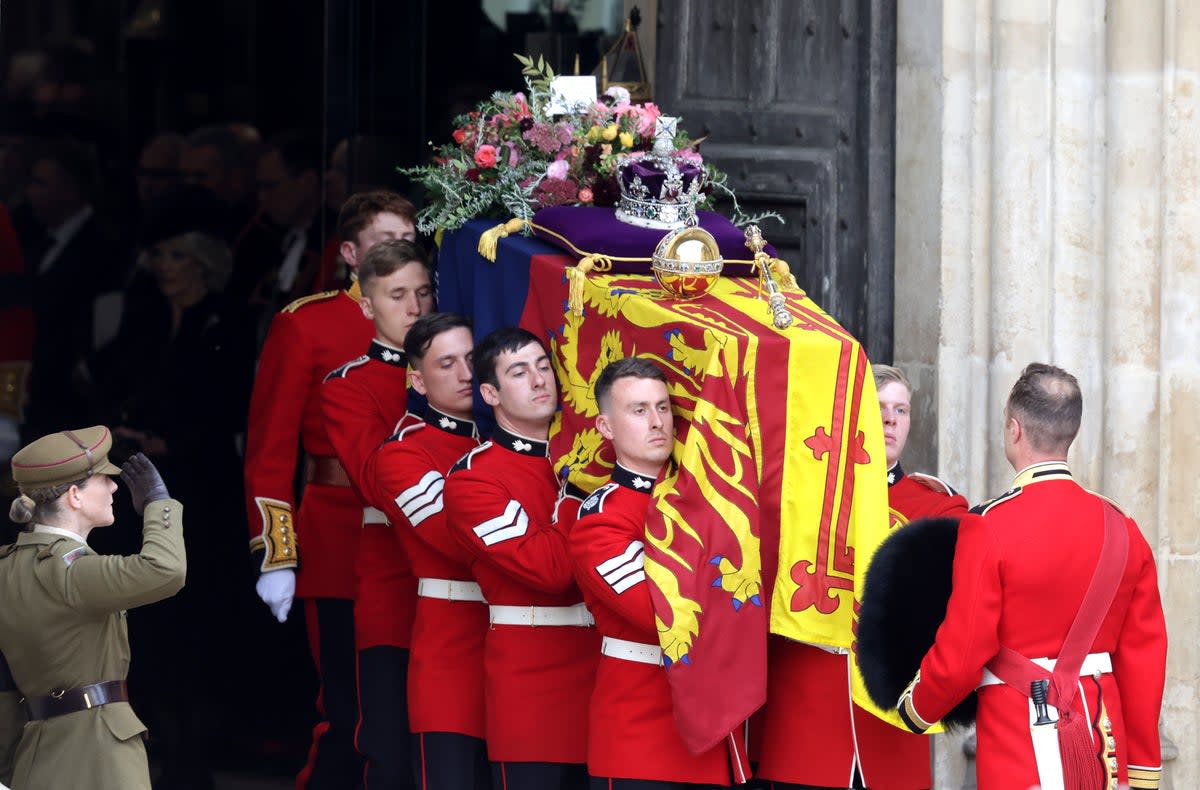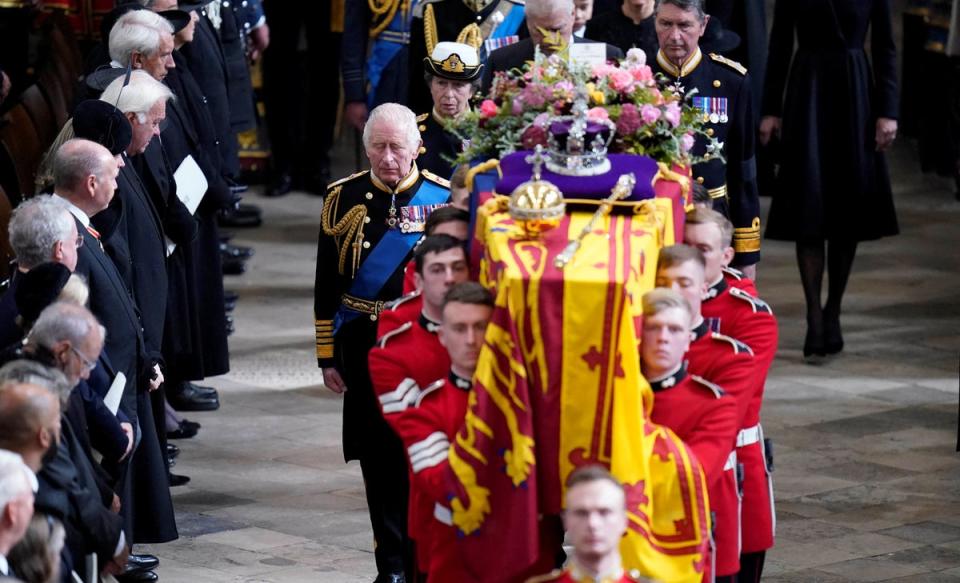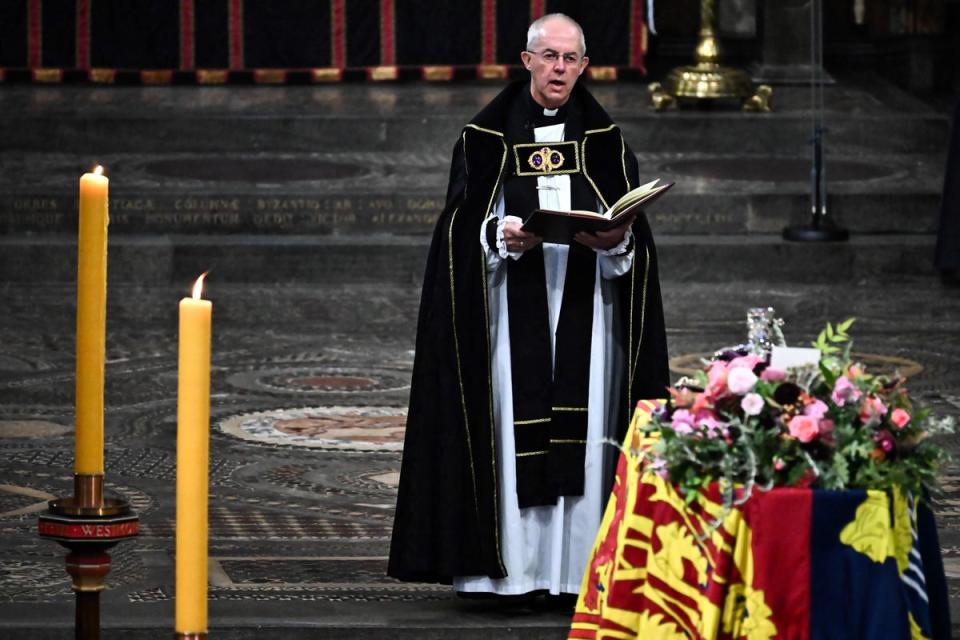Voices: A dazzling pageantry of music and poetry: The service for the Queen was Britain at its very best

- Oops!Something went wrong.Please try again later.
- Oops!Something went wrong.Please try again later.
When Elizabeth II became Queen in February 1952, her grandmother – the stern Queen Mary, widow of George V – wrote to her with some queenly advice. “Remember,” she said, “that life is made up of loyalty: loyalty to your friends; loyalty to things beautiful and good; loyalty to the country in which you live; and, above all, for this holds all other loyalties together, loyalty to God.”
Now, having served almost beyond what her physical strength would allow, the state funeral of Queen Elizabeth II at Westminster Abbey was a chance for the nation, the Commonwealth and most of the world there represented to give thanks and praise for the loyal service of a gentle Christian soul.
The abbey that married her, that crowned her – and where she took those sacred vows of literal life-long service – has now befittingly commemorated her. A quarter-century ago, Diana’s funeral was held here – a moment of danger for the House of Windsor.
The address by Charles, Earl Spencer, sent a thunderous wave of applause through the abbey and (metaphorically) around the world. His words seemed timeless – and darkly portentous: “I would like to end by thanking God for the small mercies he has shown us at this dreadful time. For taking Diana at her most beautiful and radiant and when she had joy in her private life.
“Above all, we give thanks for the life of a woman I am so proud to be able to call my sister, the unique, the complex, the extraordinary and irreplaceable Diana; whose beauty, both internal and external, will never be extinguished from our minds.” Now, sadly, the memory of Diana is fading.
Camilla is Queen Consort and King Charles III is popular – and not least because of the steadying influence of the Queen. From the perspective of today, it was the greatest evidence of Elizabeth II’s ability to get things right, even after mistakes.
The eyes of a global audience were centred on her in the abbey, just as they were for happier occasions: the coronation in June 1953, which, for many British families, was their first experience of television. Then – as now, too – there was a rare assemblage of emperors, kings, princes, dukes, presidents, chancellors and prime ministers to witness the proceedings. As the old saying goes, the crowned heads of Europe – and as far away as Japan and Brunei – paid their tribute. The golden crosses of the dignitaries of the established Church were joined by leaders of every faith.
Conducted in this near 1,000-year-old abbey, the service was a dazzling pageantry of music and poetry. One of the striking features of all the formal obsequies in recent days across England, Scotland, Wales and Northern Ireland has been the care with which music and readings have been chosen – and the precision of the ceremonial.

The service in the abbey was no exception to this rule. Much of it was of her own choosing, such as the parting and winsomely beautiful lament “Sleep, Dearie, Sleep”, delivered by the Queen’s piper, Warrant Officer Class 1 (Pipe Major) Paul Burns, an especially poignant moment.
Elizabeth also chose psalms and hymns that recalled the funeral of her mother in 2002, and that echoed her wedding to Philip, almost 75 years ago: Ralph Vaughan Williams, Edward Elgar, John Donne, Henry Purcell, Charles Wesley, Johann Sebastian Bach, the Book of Common Prayer, the Bible. “All things beautiful and good”, indeed.
Unusually, the archbishop of Canterbury, Justin Welby, broke away a little from the routine platitudes when he remarked that: “In all cases, those who serve will be loved and remembered when those who cling to power and privileges are long forgotten.” It was perhaps just as well that the television cameras didn’t, at that point, pan to Boris Johnson or Jair Bolsonaro.
Black may be the colour for mourning, but ceremonial London could scarcely have been more vibrant. There was even a rainbow over London as dawn broke, a kind of metaphor for how the Queen’s bright smile used to break the ice for the most nervous of her many visitors and guests.
The lively flags of the Commonwealth nations, of the Overseas Territories and countless union jacks brightened a mercifully dry day, with Big Ben sounding a periodic note of solemnity, occasionally accompanied by the clattering of hooves. The marching brass bands, the massed pipes and the muffled drums played tunes that were alternately solemn and breezy, appropriately for an event that was itself alternately sad, grim and celebratory.
The processions were colourful and designed to awe. The tradition of the monarch’s children and immediate family following on foot behind the coffin provided a counterpoint, grounding them on the same level as the people camped along the route. You’d not call it egalitarian, but the King was there, walking down the street; not high and mighty on horseback or obscured by bulletproof glass – but as his mother’s son, chief mourner.

Lots of nations do ceremonial well, but few have the same variety of archaic dress and uniform as the British manage. The glittering imperial state crown, orb and sceptre atop a coffin draped in the royal standard, carried on the Royal Navy state funeral gun carriage with 142 ratings pulling it along – these are impressive and unusual procedures for a head of state.
There were Canadian Mounties, Beefeaters and buglers, bearskins and archers, Blues and Royals, ostrich plumes, scarlet tunics and tabards. It was gloriously Ruritanian, the sights and sounds strongly reminiscent of the funeral rites of Victoria in 1901 (though the British armed forces are much denuded from those truly imperial times).
There wasn’t much modernisation going on – a better representation for females, and a delegation of NHS Covid heroes accompanying veterans were small concessions to change.
Generally, the admittedly resplendent spectacle did nothing to dispel the feeling that the British are so proud of their past that they prefer to live in it. Yet, it was also a reminder that a constitutional hereditary monarchy, with all its exquisitely archaic rituals, can help stabilise a country undergoing rapid social and economic transformation – as did Britain after 1952.
Twice this year, the Queen has brought the nation together. It seems much longer ago, but it’s only three months since the platinum jubilee gave the UK another welcome opportunity to take stock of its situation, have a party, and say thank you to a 96-year-old great-grandma.
As always, though not often present, the Queen was the obvious star of the jubilee, her valedictory performance with Paddington Bear so affectionately remembered, perhaps surpassing her memorable scenes with James Bond at the 2012 London Olympics. Now, at Westminster Abbey and at Windsor later, Elizabeth II is once again the centre of global attention, for the final curtain.
To keep up to speed with all the latest opinions and comment, sign up to our free weekly Voices Dispatches newsletter by clicking here
The passing of one monarch means little politically. King Charles III will no doubt try as hard as his mother to be head of the nation – and reflect back to the United Kingdom and the Commonwealth the values that, respectively, bind them together.
In her first televised Christmas Day message, in 1957, Elizabeth II popped up in the nation’s living rooms to declare: “In the old days the monarch led his soldiers on the battlefield and his leadership at all times was close and personal. Today things are very different. I cannot lead you into battle, I do not give you laws or administer justice; but I can do something else, I can give you my heart and my devotion to these old islands and to all the peoples of our brotherhood of nations.”
She was right. At a moment such as this, when the monarchy looms so large, it should again be remembered that the new King cannot solve our cost of living crisis; nor prevent the break-up of the union, nor make wars end. We ought not, even as we reflect on the distinguished service of Elizabeth II, delude ourselves about the significance of the moment – but something intangible has been lost in this past week or so; what the diplomats call “soft power”. Soft, and elegant with it.
For all the quiet, unspoken hopes nurtured for some post-Brexit national reconciliation, the resilient spirit of the Queue and the expectations for a new reign, there is a feeling that the passing of the sovereign superstar Elizabeth II leaves a nation somewhat denuded. We’ll miss her, and her unceasing loyalty to an ideal of Britain.

